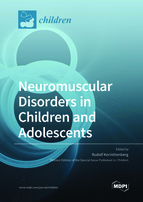Neuromuscular Disorders in Children and Adolescents
A special issue of Children (ISSN 2227-9067). This special issue belongs to the section "Child Neurology".
Deadline for manuscript submissions: closed (10 December 2021) | Viewed by 31063
Special Issue Editor
Interests: epilepsy in children; neuromuscular disorders; Duchenne muscular dystrophy; spinal muscular atrophy
Special Issue Information
Dear Colleagues,
The term “neuromuscular disorders” (NMD) includes diseases that take their origin or manifest at the anatomical and functional “neuromuscular unit”, comprised of the spinal alpha-motoneuron, the peripheral nerve and its axon collaterals, the neuromuscular synapses and the associated muscle fibers. With few exceptions, neuromuscular disorders in children are rare diseases. The overall prevalence up to the age of 15 has been estimated at 7–80/100,000. The group contains many hundreds of disease entities. Of these, some 80% are inherited. X-linked Duchenne muscular dystrophy (DMD), autosomal-recessive spinal muscular atrophy (SMA) and autosomal dominant Charcot–Marie–Tooth neuropathy type 1A are the most frequent ones (incidence between 1:2,500–1:10,000); all others are much rarer and, in part, have been described in only a few families. In children, only 20% of NMDs are acquired (inflammatory, toxic, metabolic) and accessible to a causative treatment.
During the last three decades, significant scientific and therapeutic progress has been achieved, especially in hereditary NMDs. In 1985, DMD was the first genetic disease whose genetic code could be deciphered. Since that time, continuously new genetic entities of neuromuscular diseases were defined, not infrequently with overlapping genotypes or phenotypes. As a consequence, the classification of these diseases changed from a clinical-descriptive and formal-genetic to a molecular genetic and pathophysiological one. This resulted in intensified research in the pathophysiology and therapy of these diseases, in the last years resulting in first effective gene-modifying treatments in DMD and SMA, and recently, gene replacement therapy in the most severe form of SMA. Despite this significant progress in therapeutic research, the way to cure or significantly improve life for most children and adolescents with neuromuscular disorders is still unknown and a long way off. Nevertheless, great progress has also been made in symptomatic and rehabilitative management, allowing one to significantly improve functioning and quality of life of the affected individuals and their families. In this respect, the international consensus standards have been formulated for the more prevalent disease groups, and these continuously have to be confirmed and improved by results of well-planned, controlled clinical trials.
The Special Issue on NMDs of this journal is open to all kinds of high-quality research in the field, including articles on genetics, pathophysiology, experimental therapeutic research, clinical trials, and clinical research in symptomatic, rehabilitative and psycho-social management. The whole spectrum, from reviews over original research, to important case reports, will be welcome.
Prof. Rudolf Korinthenberg
Guest Editor
Manuscript Submission Information
Manuscripts should be submitted online at www.mdpi.com by registering and logging in to this website. Once you are registered, click here to go to the submission form. Manuscripts can be submitted until the deadline. All submissions that pass pre-check are peer-reviewed. Accepted papers will be published continuously in the journal (as soon as accepted) and will be listed together on the special issue website. Research articles, review articles as well as short communications are invited. For planned papers, a title and short abstract (about 100 words) can be sent to the Editorial Office for announcement on this website.
Submitted manuscripts should not have been published previously, nor be under consideration for publication elsewhere (except conference proceedings papers). All manuscripts are thoroughly refereed through a single-blind peer-review process. A guide for authors and other relevant information for submission of manuscripts is available on the Instructions for Authors page. Children is an international peer-reviewed open access monthly journal published by MDPI.
Please visit the Instructions for Authors page before submitting a manuscript. The Article Processing Charge (APC) for publication in this open access journal is 2400 CHF (Swiss Francs). Submitted papers should be well formatted and use good English. Authors may use MDPI's English editing service prior to publication or during author revisions.
Keywords
- neuromuscular disorders
- Duchenne muscular dystrophy
- spinal muscular atrophy
- Charcot–Marie–Tooth disease
- congenital myopathies
- metabolic myopathies
- myasthenic syndromes
- limb-girdle muscular dystrophy
- diagnosis
- genetics
- pathophysiology
- therapy
- management
- rehabilitation







